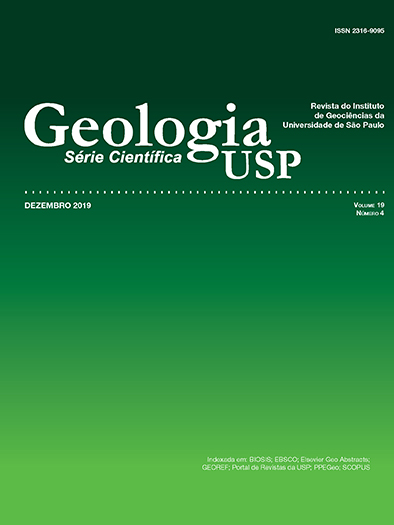Contact relationships between mafic and syenitic alkaline rocks in Jabaquara Beach, northern sector of São Sebastião Island, SP
DOI:
https://doi.org/10.11606/issn.2316-9095.v19-157121Keywords:
Alkaline rocks, Bimodal magmatism, AgmatitesAbstract
Contact relationships between syenitic rocks of the Serraria stock and plutonic to hypoabisal mafic rocks of the northern sector of the alkaline suite of São Sebastião Island are described here for the first time, allowing the indication of temporal relationships between different magmatic batches. The outcrops show a hololeucocratic syenitic variety hosting mega-, macro- and microxenoliths from different rocks forming agmatites. Five main rock units were described: alkali feldspar syenites, melasyenites, diabases, mafic cumulates (melagabbro/clinopyroxenite), and heterogeneous gabbros. Geochemically, the bimodal alkaline magmatism found on the island is well represented by the studied rocks. The sequence of magmatic events is as follows: emplacement and crystallization of basic alkaline magma batches in a magmatic chamber, forming a varieties of gabbroic cumulates, mainly olivine-bearing melagabbros and clinopyroxenites, and breccias with gabbroic matrix with evidences of textural reequilibrium by thermal action; new intrusions of alkaline basic magma batches, represented by diabase fragments, which also present textural reequilibrium (predominant granoblastic texture); syenitic magma intrusion in the mafic chamber, which fragmented the already partially or fully crystallized gabbro, carrying a large proportion of xenocrysts and xenoliths, and forming melasyenite; new syenitic magma intrusion, which fragmented the whole system forming an agmatite with megaxenoliths and microxenoliths of cumulative gabbro, diabase, agmatite with gabbroic matrix (heterogeneous gabbros) and melasyenite; pegmatite veins and dykes of quartz syenites crosscutting all lithotypes. All types sampled as xenoliths have some degree of recrystallization and chemical reaction with the final syenitic host magma.
Downloads
Downloads
Published
Issue
Section
License
Authors who publish in this journal shall comply with the following terms:
- Authors keep their copyright and grant to Geologia USP: Série Científica the right of first publication, with the paper under the Creative Commons BY-NC-SA license (summary of the license: https://creativecommons.org/licenses/by-nc-sa/4.0 | full text of the license: https://creativecommons.org/licenses/by-nc-sa/4.0/legalcode) that allows the non-commercial sharing of the paper and granting the proper copyrights of the first publication in this journal.
- Authors are authorized to take additional contracts separately, for non-exclusive distribution of the version of the paper published in this journal (publish in institutional repository or as a book chapter), granting the proper copyrights of first publication in this journal.
- Authors are allowed and encouraged to publish and distribute their paper online (in institutional repositories or their personal page) at any point before or during the editorial process, since this can generate productive changes as well as increase the impact and citation of the published paper (See The effect of Open Access and downloads on citation impact).





